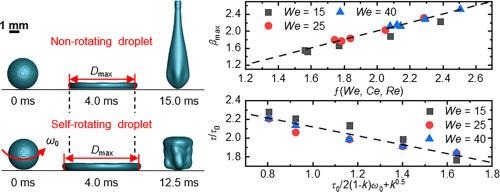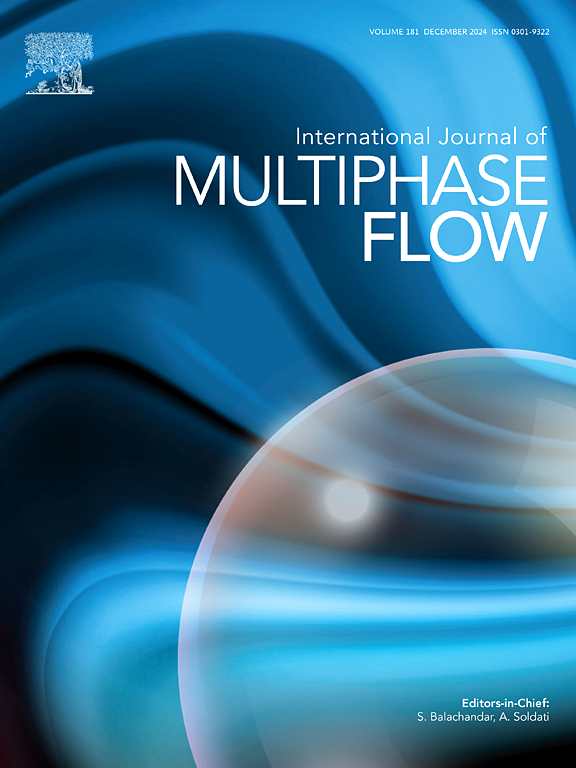Impact dynamics of self-rotating droplets on superhydrophobic surfaces
IF 3.8
2区 工程技术
Q1 MECHANICS
International Journal of Multiphase Flow
Pub Date : 2025-09-15
DOI:10.1016/j.ijmultiphaseflow.2025.105449
引用次数: 0
Abstract
Droplet impact on superhydrophobic surfaces has attracted significant attention due to its relevance to a wide range of engineering applications, such as anti-icing, self-cleaning and hydroelectric generation. In practice, droplets rarely fall vertically without initial motion. Aerodynamic and external disturbances often impart rotation, which significantly influences their impact dynamics. However, the impact dynamics of droplets with initial angular velocity on superhydrophobic surfaces remain poorly understood. Here, we investigate the dynamics of self-rotating droplets impacting superhydrophobic surfaces through numerical simulations, covering a broad range of droplet initial angular velocities from 0 to 700 rad/s. We find that increasing the droplet initial angular velocity leads to stronger centrifugal forces and higher rotational kinetic energy, which affects the balance between inertial and capillary forces, thereby enhancing droplet spreading and significantly reducing the contact time. Further, we systematically analyze how angular velocity influences both spreading and retraction stages, revealing critical mechanisms governing droplet behavior under rotational conditions. Based on these mechanisms, scaling laws are derived to accurately predict the maximum spreading coefficient and the contact time, demonstrating excellent agreement with the simulation results. These findings enhance the understanding of self-rotating droplet dynamics on superhydrophobic surfaces and provide guidance for related practical applications.

自旋液滴在超疏水表面的冲击动力学
液滴对超疏水表面的冲击由于其与防冰、自清洁和水力发电等广泛的工程应用相关而引起了人们的广泛关注。实际上,液滴很少在没有初始运动的情况下垂直下落。空气动力和外部扰动通常会导致旋转,这对它们的撞击动力学有显著影响。然而,具有初始角速度的液滴在超疏水表面上的撞击动力学仍然知之甚少。在此,我们通过数值模拟研究了自旋转液滴撞击超疏水表面的动力学,涵盖了从0到700 rad/s的液滴初始角速度范围。我们发现,增大液滴初始角速度,离心力更强,转动动能更高,从而影响惯性力和毛细力之间的平衡,从而增强液滴的扩散,显著缩短接触时间。此外,我们系统地分析了角速度如何影响扩散和收缩阶段,揭示了在旋转条件下控制液滴行为的关键机制。在此基础上,导出了能准确预测最大扩散系数和接触时间的标度律,与仿真结果吻合良好。这些发现增强了对超疏水表面自旋液滴动力学的理解,并为相关的实际应用提供了指导。
本文章由计算机程序翻译,如有差异,请以英文原文为准。
求助全文
约1分钟内获得全文
求助全文
来源期刊
CiteScore
7.30
自引率
10.50%
发文量
244
审稿时长
4 months
期刊介绍:
The International Journal of Multiphase Flow publishes analytical, numerical and experimental articles of lasting interest. The scope of the journal includes all aspects of mass, momentum and energy exchange phenomena among different phases such as occur in disperse flows, gas–liquid and liquid–liquid flows, flows in porous media, boiling, granular flows and others.
The journal publishes full papers, brief communications and conference announcements.

 求助内容:
求助内容: 应助结果提醒方式:
应助结果提醒方式:


